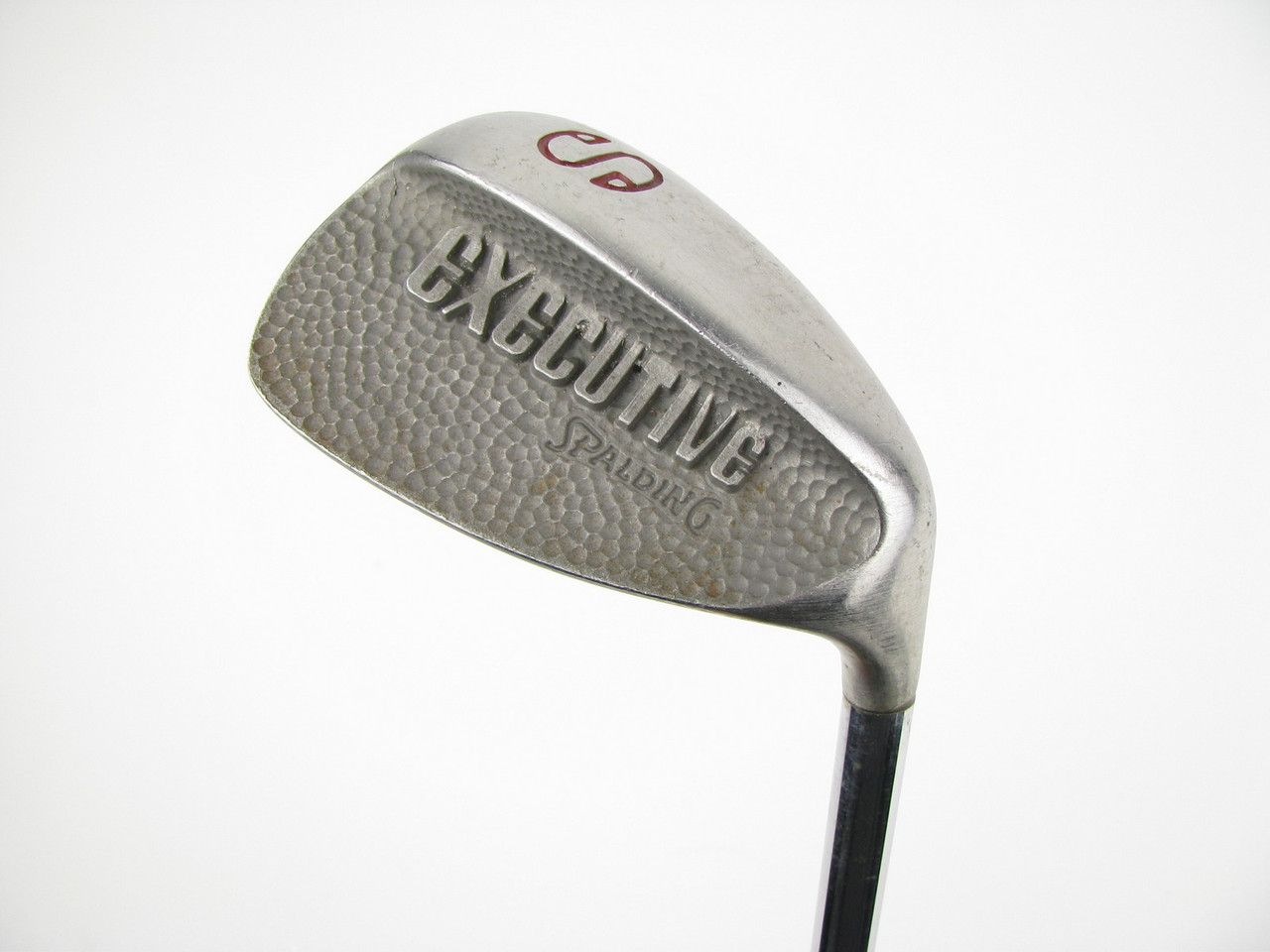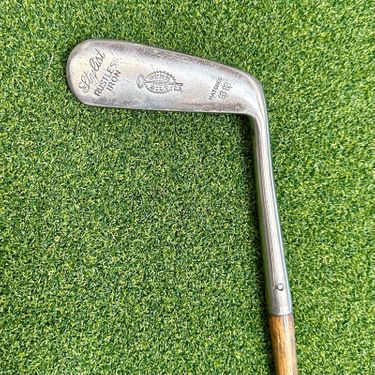Spalding began making golf equipment in the early 1900s and was one of the first companies to introduce the sport to the United States.
Having sat at the forefront of golf club innovation for much of the 20th century with popular lines like Top-Flite, Spalding ceased production of its clubs in 2002.
In this article, you’ll find a complete list of Spalding irons by year.
Spalding Irons By Year
Here is a full list of every Spalding iron release:
| Image | Spalding Iron Model | Release Year | Price |
|---|---|---|---|
 | Spalding Top-Flite XL2000 Irons | 2000 | Buy on Global Golf |
 | Spalding Pro Impact Irons | 1999 | Buy on Global Golf |
 | Spalding Executive EZX Oversize Irons | 1998 | Buy on Global Golf |
 | Spalding Top-Flite Tour Oversize Irons | 1998 | Buy on Global Golf |
 | Spalding Top-Flite Tour Ti Irons | 1997 | Buy on Global Golf |
 | Spalding Magna Oversize Irons | 1997 | Buy on Global Golf |
 | Spalding Executive OS/i Oversize Irons | 1997 | Buy on Global Golf |
 | Spalding Executive X EZ 4 Oversize Irons | 1996 | Buy on Global Golf |
 | Spalding Elite Tour Balancing System Irons | 1994 | Buy on Global Golf |
 | Spalding Tour Edition Irons | 1991 | Buy on Global Golf |
 | Spalding Top-Flite Plus Irons | 1990 | Buy on Global Golf |
 | Spalding Cannon Irons | 1985 | Buy on Global Golf |
 | Spalding XL4 Irons | 1981 | Buy on Global Golf |
Spalding Elite Plus Irons | 1979 | Buy on Global Golf | |
 | Spalding Executive Irons | 1977 | Buy on Global Golf |
 | Spalding Elite Centurion Irons | 1975 | Buy on Global Golf |
 | Spalding Executive MV2 Irons | 1972 | Buy on Global Golf |
 | Spalding Elite MV2 Irons | 1972 | Buy on Global Golf |
Spalding Top-Flite Professional Irons | 1968 | Buy on Global Golf | |
 | Spalding Executive Focal Powered Irons | 1966 | Buy on Global Golf |
 | Spalding Top-Flite Executive Synchro-Dyned Irons | 1962 | Buy on Global Golf |
 | Spalding Top-Flite Synchro-Dyned Irons | 1953 | Buy on Global Golf |
 | Spalding Kro-Flite Irons | 1940 | Buy on Global Golf |
 | Spalding Registered Irons | 1936 | Buy on Global Golf |
 | Spalding Kro-Flite RTJ Irons | 1931 | Buy on Global Golf |
 | Spalding Stop Em Irons | 1920 | Buy on Global Golf |
 | Spalding Ded Stop Irons | 1918 | Buy on Global Golf |
Spalding Irons By Year: 1918-1949

The very first Spalding irons were introduced in 1918 with the Ded Stop model.
Marketed as “golf’s greatest iron club,” the Ded Stop irons marked Spalding’s entry into golf club manufacturing, which would continue over the next century.
Throughout this period, Spalding experimented with numerous groove designs to increase spin, including the waffle face pictured above. Other versions featured a small black insert in the sweet spot for improved accuracy and feel.
Until the USGA banned deep-grooved irons, Spalding’s Ded Stop clubs brought a smile to countless players’ faces.
My Golf Museum
In the 1920s, Spalding irons like the Stop Em model focused on weight placement by moving more mass towards the toe and heel areas of the clubhead for increased forgiveness. This was an early iteration of perimeter weighting, a technology that would evolve substantially in the coming decades.

Around 1931, Spalding launched the Kro-Flite RTJ (Robert Trent Jones) irons. This model added complexity and was built for consistent distances and accuracy.
Spalding was cementing itself as an innovator willing to test new club engineering theories and bring them to market. The company pioneered the process of “drop forging” to mass-manufacture its golf club heads, allowing for rapid scale.
The 1940 Kro-Flite irons incorporated manufacturing techniques used in World War II to redirect weight savings to the clubhead perimeter — perhaps the earliest example of game improvement irons. By the post-war late 1940s, Spalding had claimed the title as the #1 golf equipment company in America.
Spalding Irons By Year: 1950-1969

With rapidly growing interest in recreational golf in the 50s and 60s, Spalding ramped up the production of its clubs to unprecedented levels.
In 1953, Spalding released the iconic Top-Flite Synchro-Dyned series. These irons were designed to be more forgiving than previous models, with a broader top line to add confidence. Spalding’s goal: make golf “a lot more fun.”
By the 1960s, Spalding’s Top-Flite line was an established name in the premium golf club space. In 1968, the company released the Top-Flite Professional irons. Check out the video below by The Vintage Golfer to see them in action:
Spalding Irons By Year: 1970-1979
By the 1970s, Spalding irons were some of the most played in golf alongside Wilson irons and MacGregor irons. It was certainly a golden period for these brands.
In 1972, it introduced the Executive MV2 and Elite MV2 irons. Fitted with steel shafts, they featured forged stainless steel heads with a polished finish.

In 1977, the company launched a new version of the Executive irons. This club was in production for over 8 years and featured a hammered finish on the back of the club head. The Executive branding is debossed on the rear of the cavity.
Check out the Executive irons in action in the video below:
A similar hammered texture was utilized on the Elite Plus irons, which were launched in 1979. This time round, the irons were built with a larger cavity, as perimeter weighting technology became preferred during this period.
Spalding Irons By Year: 1980-1989

In 1981, Spalding introduced the XL4 irons. These clubs were engineered with an angular cavity design, and once again catered for the mid to high-handicapper.
By the mid-1980s, the company embraced investment casting manufacturing to enable designs like the Cannon irons with extreme perimeter weighting.
Spalding Irons By Year: 1990-2000

With CAD design taking hold, Spalding engineers had more precision than ever to craft exotic iron shapes and weight placement schemes.
Irons like 1997’s Magna line concentrated mass well behind the hitting area by forming large cavity backs, reminiscent of today’s game improvement irons.
Around this time, Spalding employed golf club designer Jeff Sheets to design a line of clubs titled Tour Ti. Featuring a cavity back design and a muscle shaft, the irons had a clubface made from 100% titanium for optimal weight and power.
Sadly, this was one of the final Spalding designs. The brand ceased production of its golf clubs in the early 2000s, bringing over 80 years of history to a close.


